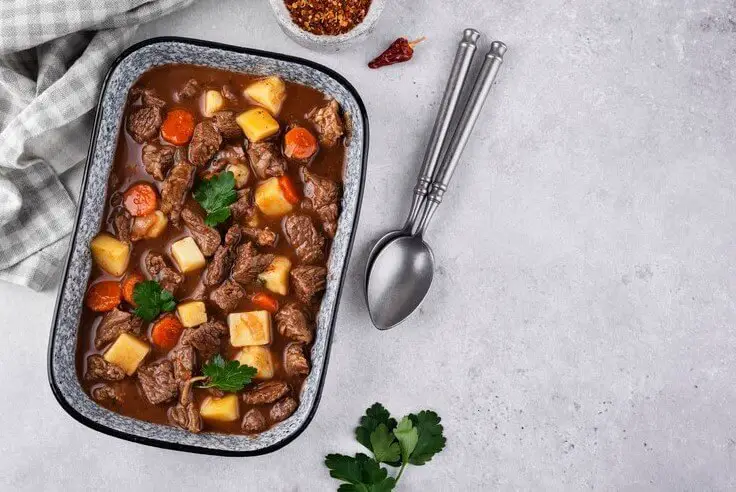Beef stew is a quintessential comfort food, known for its rich, deep flavors and hearty ingredients. Traditionally, many recipes call for the addition of wine, which is believed to enhance the taste and aroma of the stew. However, there’s a growing need for a beef stew recipe that omits wine, catering to those who avoid alcohol for health, dietary, or personal reasons.
Introduction: Embracing the Richness of a Wine-Free Beef Stew
The importance of avoiding wine in beef stew cannot be overstated for certain groups of individuals. For those sensitive to sulfites – compounds commonly found in wines – the inclusion of wine in recipes can trigger allergic reactions or other health issues. Sulfites are used as preservatives in many food products, including wine, and can cause symptoms ranging from mild to severe in sensitive individuals. By eliminating wine from beef stew, the dish becomes more accessible and safer for those with sulfite sensitivities.
Similarly, histamine, another compound found in wine, can be problematic for many. Histamines are naturally occurring chemicals that can exacerbate symptoms in people with histamine intolerance or certain types of migraines. Cooking with wine can inadvertently introduce a high level of histamines into the dish, making it unsuitable for those with such sensitivities. A beef stew recipe without wine circumvents this issue, offering a delicious alternative that is more inclusive.
Moreover, the benefits of a wine-free beef stew extend beyond catering to dietary restrictions. It allows the natural flavors of the beef, vegetables, and herbs to shine through more prominently. The richness of the beef and the earthiness of the vegetables are not overshadowed by the wine’s flavor, creating a more nuanced and balanced dish. This approach to cooking beef stew also opens up the dish to a wider audience, including children and those who abstain from alcohol for religious or personal reasons.
In summary, a beef stew recipe without wine is not just a mere alternative; it’s a thoughtful adaptation of a classic dish. It respects dietary needs and preferences while still delivering the warmth and heartiness that beef stew is celebrated for. This version promises a comforting and satisfying meal that is inclusive and enjoyable for everyone at the table.

Ingredients and Substitutions: Crafting the Perfect Non-Alcoholic Beef Stew
Creating a flavorful beef stew without wine involves careful selection of ingredients and understanding their roles in the dish. Each component, from the cut of beef to the choice of thickening agents, plays a pivotal role in crafting a stew that is both delicious and accommodating to various dietary needs.
Selecting the Right Beef Cut
- Chuck Roast Over Pre-Packaged Stew Meat: The choice of beef is crucial in a stew. Chuck roast is preferred for its rich marbling and connective tissues, which break down during slow cooking, resulting in tender, flavorful meat. Pre-packaged stew meat, often a mix of various cuts, can lead to inconsistent texture and flavor. Chuck roast ensures a uniform taste and tenderness, making it the ideal choice for a stew that’s both hearty and delectable.
Vegetables and Flavor Enhancers
- Role of Carrots, Celery, Garlic, and Shallots: These vegetables are more than just fillers; they are flavor enhancers. Carrots add a subtle sweetness, celery contributes a slight bitterness and crunch, garlic offers a pungent kick, and shallots bring a mild, sweet onion flavor. Together, they create a harmonious base that complements the beef wonderfully.
- Choosing the Right Potatoes: Potatoes are not just a source of starch; they’re a texture and flavor component. Yukon gold potatoes are ideal for their creamy texture and buttery taste, which hold up well during the cooking process without disintegrating.
Flour and Thickening Alternatives
- Gluten-Free Options: Traditional stew recipes use wheat flour as a thickener, but for a gluten-free version, alternatives like cornstarch or a gluten-free all-purpose flour blend can be used. These substitutes work well to thicken the stew while keeping it accessible to those with gluten sensitivities.
Butter or Oil?
- Flavor Differences and Dairy-Free Options: The choice between butter and oil can affect the stew’s flavor profile. Butter adds a rich, creamy taste, enhancing the overall richness of the stew. For a dairy-free version, olive oil is an excellent alternative, offering a lighter flavor while maintaining the dish’s heartiness.
Herbs for Flavor
- Fresh vs Dried Herbs: The use of herbs in beef stew adds depth and complexity. Fresh herbs provide a bright, vibrant flavor, while dried herbs offer a more concentrated, earthy taste. A combination of fresh rosemary, dried thyme, and bay leaves can create a well-rounded flavor profile that complements the beef and vegetables beautifully.
In summary, the ingredients and their substitutes in a beef stew recipe without wine are not just about avoiding certain elements; they are about creating a dish that is rich in flavor, texture, and aroma. Each ingredient is selected to contribute to the overall harmony of the dish, ensuring that the final stew is satisfying, wholesome, and inclusive of various dietary preferences and needs.
Cooking Method: Mastering the Art of a Flavorful Beef Stew Without Wine
The cooking process for a beef stew without wine is a journey of building layers of flavor. Each step, from searing the beef to simmering the stew, is crucial in achieving a rich and satisfying dish. Here’s a detailed guide to preparing and cooking your beef stew, along with some essential tips for searing the beef.
Beef Stew Recipe Without Wine : Step-by-Step Cooking Process
- Preparation: Begin by cutting the chuck roast into uniform, bite-sized pieces. This ensures even cooking. Dice your vegetables – carrots, celery, shallots, and garlic – and set them aside. If you’re using potatoes, chop them into chunks that are not too small to prevent them from disintegrating during the cooking process.
- Searing the Beef: Heat a large pot or Dutch oven over medium-high heat. Add butter or oil, and once hot, add the beef chunks in batches. Sear the beef until it develops a deep brown crust on all sides. This step is crucial for developing a rich flavor in the stew. Once browned, remove the beef and set it aside.
- Cooking the Vegetables: In the same pot, add the shallots, carrots, and celery. Sauté them until they start to soften. Add the garlic and cook for another minute, ensuring it doesn’t burn.
- Combining Ingredients: Return the beef to the pot. Sprinkle with flour (or your chosen gluten-free alternative) and stir well, so the beef and vegetables are evenly coated. This helps to thicken the stew.
- Adding Liquids and Herbs: Pour in your chosen broth (beef or vegetable), ensuring it covers the beef and vegetables. Add your herbs – rosemary, thyme, and bay leaves. Bring the mixture to a boil, then reduce the heat to a simmer.
- Simmering: Cover the pot and let the stew simmer for about 1.5 to 2 hours. The stew is ready when the beef is tender, and the flavors have melded together. In the last 30 minutes of cooking, add the potatoes.
- Final Adjustments: Taste and adjust the seasoning as needed. Remove the bay leaves and any large herb stems before serving.
Tips for Rich Flavor and Texture for Beef Stew Recipe Without Wine
- Avoid Overcrowding: When searing the beef, avoid overcrowding the pan. Overcrowding leads to steaming rather than searing, which can result in less flavor development. Cook the beef in batches if necessary.
- High Heat: Ensure the pan is hot before adding the beef. This helps to create a good sear, locking in flavors.
By following these steps and tips, you’ll create a beef stew that’s rich in flavor, with tender beef and perfectly cooked vegetables, all without the need for wine. This method ensures a stew that’s not only delicious but also suitable for a variety of dietary needs.

Broth Choices for Your Non-Alcoholic Beef Stew
Choosing the Right Broth
Beef Broth
- Richness and Depth: Beef broth is the traditional choice for beef stew, offering a deep, meaty flavor that complements the beef. It provides a robust base that enriches the overall taste of the stew.
- Considerations: When selecting beef broth, opt for low-sodium versions to control the salt content. Also, consider the quality of the broth; a well-made, flavorful beef broth can significantly elevate the dish.
Learn more about Butcher’s Beef Bone Broth for a deeper understanding of broth choices.
Vegetable Broth
- A Lighter Alternative: Vegetable broth is a fantastic alternative for those seeking a lighter stew or catering to vegetarian preferences. It imparts a subtle, earthy flavor while allowing the other ingredients to shine.
- Choosing a Broth: Look for a vegetable broth that’s rich and has a balanced flavor profile. Some broths can be overly seasoned, so it’s essential to taste and adjust the seasoning of your stew accordingly.
Homemade Broth Options
- Customization and Control: Making your own broth allows you to control the ingredients and the intensity of flavors. Homemade beef or vegetable broth can be tailored to your taste preferences and dietary needs.
- The Process: To make a homemade broth, simmer bones (for beef broth) or a mix of vegetables (for vegetable broth) with herbs and spices for several hours. This slow cooking process extracts flavors, resulting in a rich and aromatic broth.
Tart Cherry Juice and Coconut Aminos
- Adding Complexity: In the absence of wine, tart cherry juice can add a touch of tartness and color to the stew, mimicking some of the characteristics of red wine.
- Umami Flavor: Coconut aminos, a soy sauce alternative, can be used to introduce an umami depth to the stew. It’s a subtle way to enhance the savory notes without overpowering the other flavors.
Check out the Dinty Moore Beef Stew Recipe, a classic take on this beloved dish.
Beef Stew Without Wine : Storage and Freezing
Proper storage and freezing techniques can extend the life of your beef stew, making it a convenient option for meal prep. The stew can be stored in the fridge for 3-5 days or frozen for longer periods.
FAQs about Beef Stew Without Wine
Enhancing Flavor Without Wine
- Quality beef and a good broth are essential for a flavorful stew. Searing the meat before adding it to the stew also adds depth to the flavor.
Substitutes for Beef Broth
- A high-quality vegetable broth or a combination of broth and tart cherry juice can be used as substitutes.
Conclusion
This beef stew recipe without wine is a testament to the fact that dietary restrictions don’t have to mean sacrificing flavor. With the right ingredients and techniques, you can enjoy a rich, hearty stew that is both comforting and compliant with your dietary needs. For more culinary inspirations, explore our homemade pizza recipes that are perfect for any home cook.
Additional Resources and Recipes
For more inspiration and recipes like this wine-free beef stew, follow @thedizzycook on Instagram and explore the community’s creations under #thedizzycook on Instagram.
